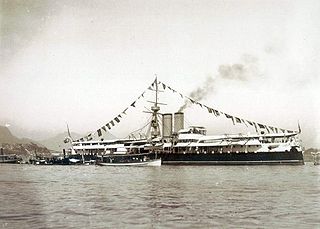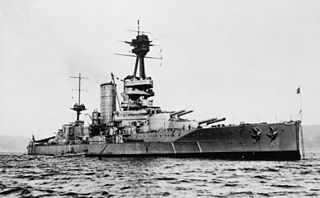Related Research Articles
USS Iowa may refer to several vessels:
Five ships of the Royal Navy have been called HMS Agincourt, named after the Battle of Agincourt of 1415, and construction of another was started but not completed.

The Brazilian Navy is the naval service branch of the Brazilian Armed Forces, responsible for conducting naval operations. The Brazilian Navy is the largest navy in Latin America and the second largest navy in the Americas after the United States Navy.
Seven vessels of the British Royal Navy have been named HMS Valiant.
Riachuelo is a word in the Spanish language, meaning a small river with little current or a brook or an arroyo.
A naval race had developed in the Aegean after the end of the Balkan Wars, with the Ottoman government ordering several ships, including two dreadnoughts, in Britain. In the event, with the outbreak of World War I, one of these ships, including further two scout cruisers and four destroyers, were confiscated and pressed into service with the Royal Navy. This disappointed the Ottomans, contributing to their joining the Central Powers in the Great War.

The QF 3-pounder Hotchkiss or in French use Canon Hotchkiss à tir rapide de 47 mm were a family of long-lived light 47 mm naval guns introduced in 1886 to defend against new, small and fast vessels such as torpedo boats and later submarines. There were many variants produced, often under license which ranged in length from 32 to 50 calibers but 40 caliber was the most common version. They were widely used by the navies of a number of nations and often used by both sides in a conflict. They were also used ashore as coastal defense guns and later as an anti-aircraft gun, whether on improvised or specialized HA/LA mounts.


Minas Geraes, spelled Minas Gerais in some sources, was a dreadnought battleship of the Brazilian Navy. Named in honor of the state of Minas Gerais, the ship was laid down in April 1907 as the lead ship of its class, making the country the third to have a dreadnought under construction and igniting a naval arms race between Brazil, Argentina, and Chile.

Riachuelo was a Brazilian ironclad battleship completed in 1883. She was named in honour of the Battle of Riachuelo in 1865. Built in the United Kingdom, the ship entered service with the Brazilian Navy in 1883 and remained in service until 1910.

The Rivadavia class consisted of two battleships designed by the American Fore River Shipbuilding Company for the Argentine Navy. Named Rivadavia and Moreno after important figures in Argentine history, they were Argentina's entry in the South American dreadnought race and a counter to Brazil's two Minas Geraes-class battleships.

The Almirante Latorre class consisted of two super-dreadnought battleships designed by the British company Armstrong Whitworth for the Chilean Navy. They were intended to be Chile's entries to the South American dreadnought race, but both were purchased by the Royal Navy prior to completion for use in the First World War. Only one, Almirante Latorre (HMS Canada), was finished as a battleship; Almirante Cochrane (HMS Eagle), was converted to an aircraft carrier. Under their Chilean names, they honored Admirals (Almirantes) Juan José Latorre and Thomas Cochrane; they took their British names from what was then a dominion of Canada and a traditional ship name in the Royal Navy.

A naval arms race among Argentina, Brazil and Chile—the wealthiest and most powerful countries in South America—began in the early twentieth century when the Brazilian government ordered three dreadnoughts, formidable battleships whose capabilities far outstripped older vessels in the world's navies.
Rio de Janeiro (ship) may refer to:
Riachuelo was a battleship project for the Brazilian Navy developed between 1913 and 1914. It was designed to be the most powerful warship of its time; it was a Brazilian response to the Chilean projects Almirante Latorre and Almirante Cochrane and to the Argentine projects Rivadavia and Moreno, during the naval arms race in South America. The construction would be carried out by the British construction company Armstrong Whitworth and Vickers, under the codename Project 781, a project chosen among several other plans offered to the Brazilian authorities. The battleship would be 188.98 meters long and have at least eight 381-millimeter guns, displacing up to 30,500 nautical tons.

Riachuelo (S40) is a Brazilian Riachuelo-class submarine built for the Brazilian Navy by DCNS in Cherbourg and ICN in Itaguaí, Brazil.

Humaitá (S41) is a Brazilian Riachuelo-class submarine built for the Brazilian Navy by ICN in Itaguaí, and DCNS.

The Foca class, or simply F, was the first naval class of submarines operated by the Brazilian Navy. It consisted of the F1, F3 and F5 submarines designed by Italian naval engineer Cesare Laurenti and built in La Spezia, Italy. The name Foca comes from the Portuguese vessel of the class. The class was part of Brazil's 1906 naval program to acquire warships to modernize its navy. The submarines were acquired to serve as a training and maintenance platform for the crews, with few naval actions during the 19 years they were active. The navy incorporated the class on 17 July 1914 and, as a result, expanded its naval structure to house these new vessels, such as the creation of the first naval school for submariners and the incorporation of ships designed to support submarines only.
References
- ↑ "NAVIOS DE GUERRA BRASILEIROS - 1822 - Hoje" (in Portuguese). Retrieved 8 December 2020.